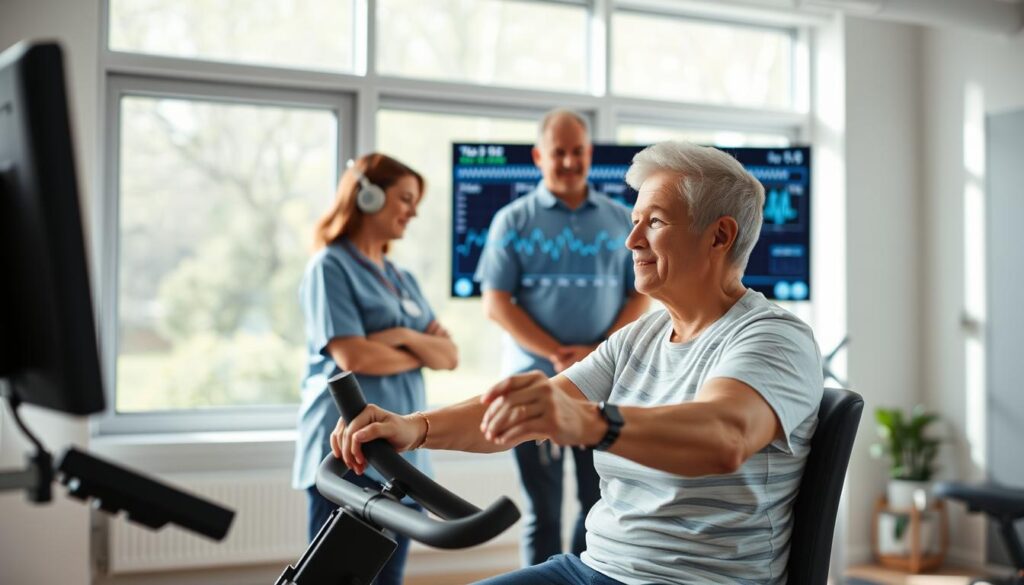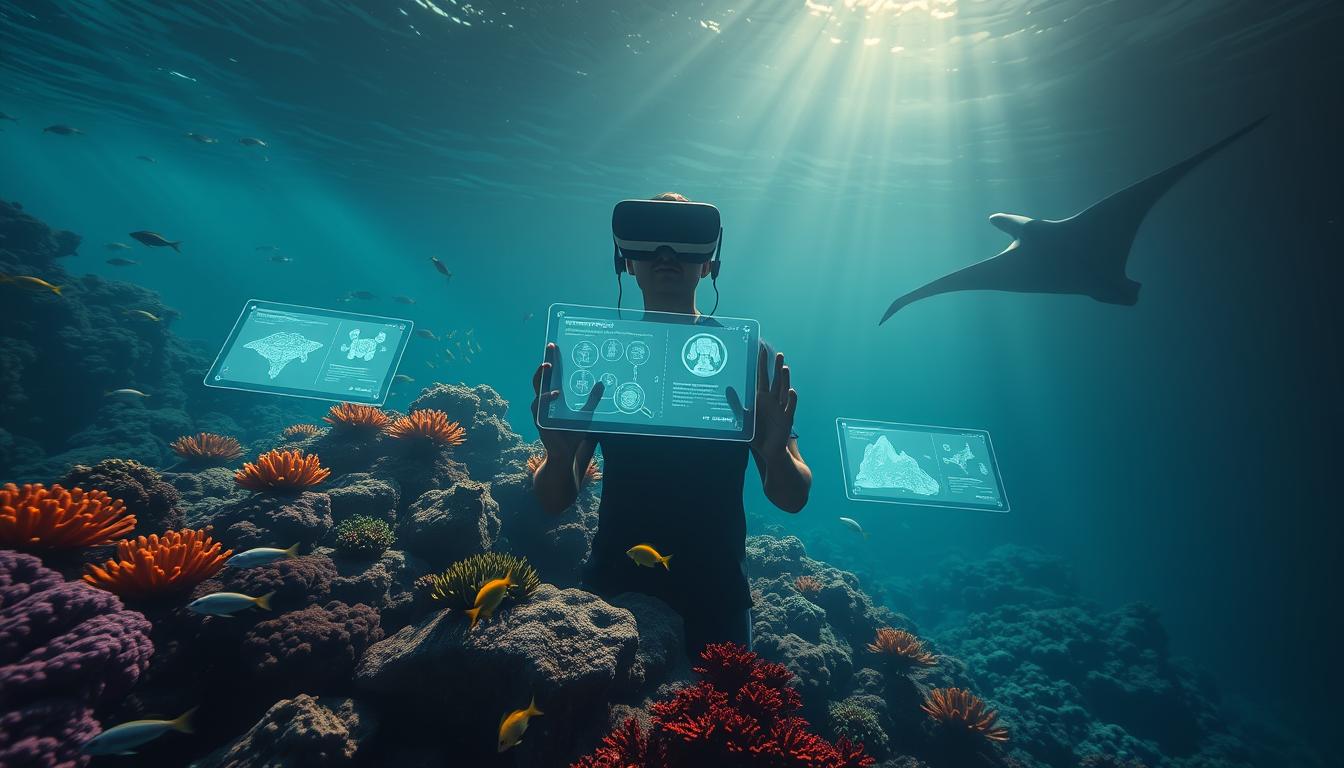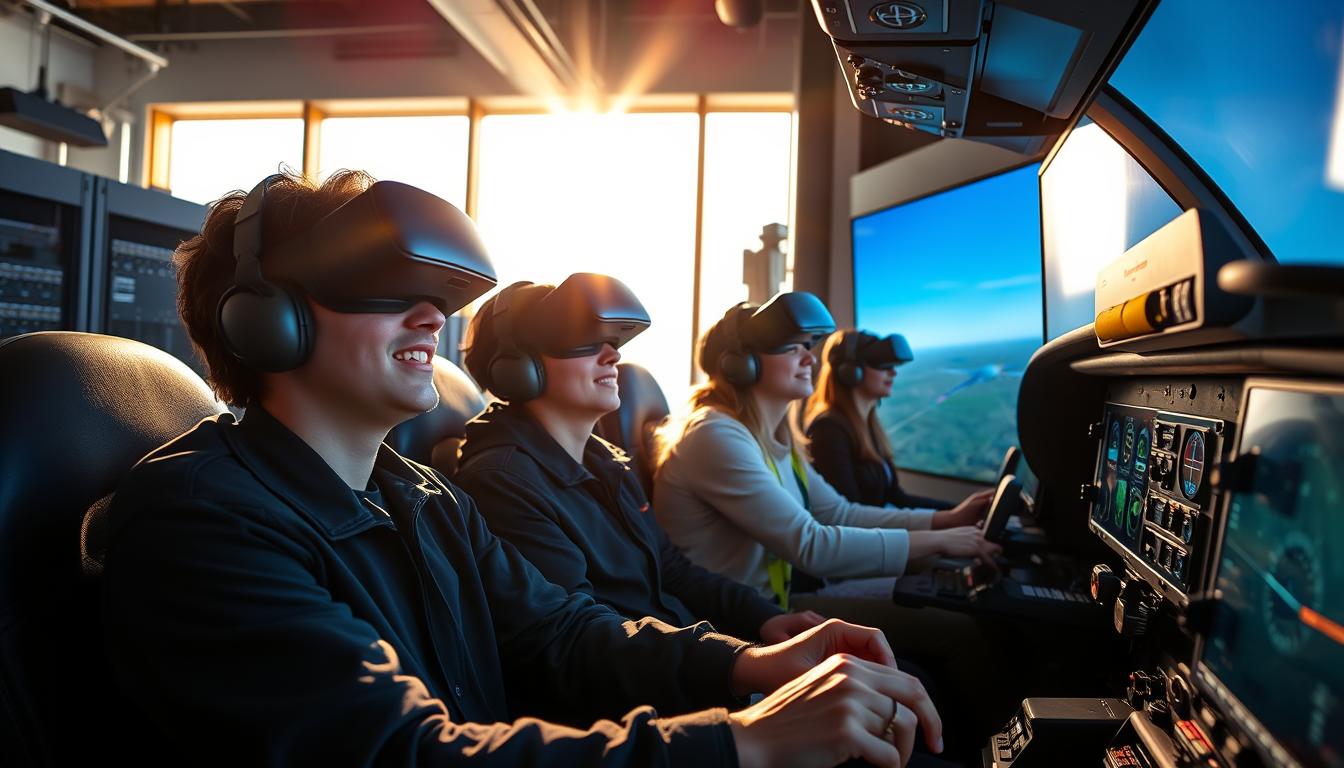Can immersive technology really change respiratory rehab? Chronic diseases like asthma and COPD affect millions. This has sparked a search for new solutions. Now, VR tools are making a big impact, offering a fresh way to improve lung health.
These tools are changing how we think about lung care. They make treatment fun and interactive. This could be a big step forward in helping patients breathe better.
Introduction to Respiratory Rehabilitation
Respiratory rehabilitation is a program for people with chronic lung diseases. It includes exercise, education, and behavior changes. These help improve physical and emotional health.
In pulmonary rehabilitation, patients learn to manage their symptoms. They also improve lung function and live healthier. The programs focus on physical activity and self-management skills.
Managing chronic lung diseases is crucial. Many people face severe symptoms that affect their life quality. Healthcare keeps improving, so does respiratory rehabilitation. This ensures patients get the best care.

The Need for Improved Respiratory Rehabilitation
Effective respiratory rehabilitation is key for managing chronic conditions like asthma and COPD. Yet, traditional programs have big gaps. These gaps hurt patient results and add to the healthcare system’s load.
Challenges in Traditional Rehabilitation Approaches
Rehabilitation programs face many hurdles. Limited access, long waits, and low motivation are common. These issues make it hard for people to stick with their plans.
Standard methods often fail to inspire patients. This leads to a search for new ways to motivate and improve adherence.
Impact of Chronic Respiratory Diseases
Chronic respiratory diseases do more than just cause symptoms. They affect people’s lives and require ongoing care. Symptoms like breathing trouble and coughs increase medical needs.
Without good rehabilitation, symptoms get worse. This makes it urgent to find new ways to tackle these health challenges.

The Role of Technology in Rehabilitation
Technology is changing how we do rehabilitation. It makes it easier for patients to get involved and track their progress. Digital health tools help doctors overcome old therapy challenges.
Tools like virtual reality (VR) create real-life-like experiences for patients. This makes them more involved in their recovery. It also lets them set up their therapy to fit their needs.
Technology also makes therapy available at home. This makes it easier for more people to get help. It also helps reduce the shame of going to therapy in person.
What is Virtual Reality?
Virtual reality is a computer-generated world that lets users dive into a three-dimensional space. It’s a new way to interact in an artificial world. This technology has grown a lot and is now used in many areas, especially in healthcare.
VR changes how we do therapy and rehab. It offers new ways to help people get better.
Definition and Overview of VR Technology
Virtual reality simulates real-life scenes in a fun and controlled way. People wear headsets that show them what’s happening and play sounds. This makes them feel like they’re really there.
This is great for health because it helps patients learn and get better in new ways. It’s especially good for those who need special help.
The Evolution of VR in Healthcare
VR started as a game but now it’s a big deal in healthcare. It used to just be for fun, but now it helps teach patients and treat them. New tech has made VR better for health, helping patients get more involved.
This is especially true for people with long-term health issues. They get to interact in a way that’s fun and engaging.
Benefits of VR Tools for Respiratory Physiotherapy and Chest Mobility
VR tools bring big benefits to respiratory physiotherapy. They make therapy more engaging and fun. This helps patients do better and feel more motivated. Plus, VR makes therapy available to more people, fitting their needs and schedules.
Enhanced Engagement and Motivation
VR changes how we do therapy. It makes therapy fun and exciting. Patients want to do their exercises because they enjoy it.
This enjoyment boosts motivation. It helps patients stick with their therapy plans. They see progress and feel good about it.
Accessibility and Treatment Flexibility
VR makes therapy easy to get to, even from home. It’s great for people who can’t move around much or live far away. VR lets therapists create therapy plans that fit each patient’s needs.
How VR Games are Used in Physical Rehabilitation
VR games are changing physical therapy. They mix fun gaming with serious exercises. This makes therapy more engaging and helps patients stick to their plans.
Examples of Popular VR Games in Respiratory Rehabilitation
Games like “Reflex Ridge” and “KidBreath” are great for breathing exercises. They make players practice good breathing while having fun. These games boost lung health and fitness.
Integration with Physiotherapy Protocols
VR fits well into traditional therapy plans. Working with doctors, VR tools are tailored to each patient. This mix of VR and old-school therapy gives patients a full care experience.
VR Tools for Respiratory Physiotherapy and Chest Mobility: Clinical Evidence
Recent clinical evidence for VR rehabilitation shows VR tools are promising for respiratory physiotherapy. Studies have looked into how VR improves patient outcomes. They found VR can boost exercise capacity and health in people with asthma and COPD.
VR tools make exercises fun and help improve breathing. They keep patients engaged and motivated. Systematic reviews confirm VR improves lung function in many people.
VR technology is changing respiratory care for the better. It helps reduce the impact of chronic respiratory diseases. More research is needed to make VR a standard part of physiotherapy.
Patient Engagement and Adherence
Understanding what patients need and want is key to better engagement in rehab programs. Using patient-focused methods in treatment boosts adherence. When patients feel heard, it builds a team effort in therapy.
This teamwork leads to more active participation. And that means better health results.
The Importance of Patient-Centric Approaches
Patient engagement strategies look at what drives and holds back patients from treatment. Customizing rehab plans makes sticking to them more likely. By matching therapy to what patients enjoy, care providers make treatment more meaningful.
This approach encourages patients to stay committed to their rehab. They are more likely to follow their treatment plans.
Engaging Younger Populations through Gamification
Gamification in health brings new ways to engage and motivate young patients. Using VR to engage youth makes therapy fun and interactive. VR games for kids make health care fun and help them take ownership of their health.
This fun approach boosts adherence. It makes rehab a positive and rewarding experience for young patients.
Effectiveness of VR Interventions in Improving Lung Function
Virtual reality (VR) is being used in respiratory therapy to help patients breathe better. Studies show VR can really help patients. It makes them more active in their therapy, leading to better lung health.
Research Findings on Clinical Outcomes
VR is proving to be a game-changer in treating lung issues. Patients who use VR do better in lung tests and exercise. It also makes them feel less anxious, which helps them recover faster.
| Study | Participants | Lung Capacity Improvement | Exercise Performance |
|---|---|---|---|
| Study A | 50 | 20% increase | 15% improvement |
| Study B | 30 | 25% increase | 18% improvement |
| Study C | 40 | 22% increase | 14% improvement |
VR is making a big difference in how we treat lung problems. It’s changing healthcare for the better. More research will show even more ways VR can help patients breathe easier.
Future Directions of VR in Respiratory Rehabilitation
The world of respiratory rehabilitation is changing fast, thanks to VR. It’s now possible to treat patients in a more complete way. This means helping them physically and mentally at the same time.
This new approach could make therapy more effective. It focuses on the whole person, not just their illness. This is key to helping patients get better and stay healthy.
Potential for Holistic Approaches
VR can make therapy better by adding mental and emotional support. It uses new VR tech to create immersive experiences. These experiences help patients feel more connected and involved in their recovery.
With VR, treatments can be made just for each person. This might make patients more likely to stick with their therapy. It could also make treatments more effective.
Challenges and Limitations to Overcome
Even though VR is promising, there are big challenges to face. The cost of starting VR programs can be too high for some clinics. This makes it hard for them to use this technology.
Also, training doctors and nurses to use VR is another big problem. There’s a need for more research to prove that VR works well for different patients. This research is crucial for showing VR’s value in therapy.
To fully use VR in respiratory rehab, we must tackle these challenges. By doing so, we can offer better and more effective treatments. This will help people with respiratory problems get the care they need.
The Experience of Patients Using VR Tools
Patients who use VR tools during rehab share important insights. Their stories show the emotional and practical benefits of VR. They talk about feeling more motivated, enjoying therapy, and feeling a sense of accomplishment.
Patient Testimonials and Feedback
Reviews from VR rehab programs often highlight positive results. Common points include:
- Increased Engagement: Patients say VR makes them stay focused and interested in their exercises.
- Enjoyable Experience: They find the games in VR make rehab fun and rewarding.
- Improved Lung Function: Many see better lung health, thanks to the interactive VR exercises.
These patient stories offer valuable insights into VR’s impact on rehab. Their feedback helps build evidence for using VR in therapy.
Integrating VR into Existing Rehabilitation Programs
Adding VR to rehab needs careful planning. It’s important to work well with teams from different fields. This teamwork helps make VR a part of therapy smoothly.
Creating plans for using VR is key. It helps make sure VR fits the needs of all patients. Making VR experiences special for each person makes treatment better. It keeps patients interested and involved.
Using VR right makes rehab better for everyone. It mixes old ways of therapy with new tech. This way, patients get help for their body, mind, and feelings. It makes them more likely to stick with their treatment and get better.
Best Practices for Implementing VR in Rehabilitation
Virtual reality (VR) technology is changing rehabilitation. It’s key for healthcare pros to get the right training. This ensures they use VR tools well to help patients.
Training Healthcare Professionals on VR Tools
Training for VR should mix theory and practice. Hands-on workshops boost confidence and skill. Keeping up with VR’s latest advancements is also important.
| Training Component | Description | Benefits |
|---|---|---|
| Theoretical Knowledge | Understanding VR technology, its benefits, and limitations. | Enables informed decisions and effective treatment planning. |
| Hands-On Workshops | Practical sessions with VR tools to familiarize therapists with equipment. | Enhances user confidence and competence in real-world applications. |
| Continuous Professional Development | Regularly scheduled training sessions to introduce new VR technologies and techniques. | Ensures ongoing proficiency and engagement with current best practices for VR rehab implementation. |
By using these training methods, healthcare pros can use VR to better help patients.
Conclusion
Virtual reality is changing respiratory physiotherapy for the better. It brings new tools that help patients in ways old methods can’t. These tools make treatment plans more fun and personal, helping patients stick to them better.
Patients see big improvements in their lung health and overall well-being. This is thanks to the engaging nature of VR in their therapy.
The future of respiratory care looks bright with VR. More research will show how effective it is. This means VR will become a bigger part of treating respiratory diseases.
Healthcare will get better as VR becomes more common. It will make treatments more effective and enjoyable. This is great news for people with chronic respiratory diseases.
VR is a big step forward in healthcare. It combines cutting-edge tech with care that focuses on the patient. This could change how we treat respiratory health for the better.
FAQ
How can VR technology enhance respiratory rehabilitation?
VR technology makes respiratory rehab more fun and personal. It keeps patients engaged and motivated. This leads to better treatment results.
What types of chronic respiratory diseases can benefit from VR rehabilitation?
VR helps with diseases like asthma and COPD. It improves lung function and breathing skills.
Are there specific VR games designed for respiratory rehabilitation?
Yes, games like “Reflex Ridge” and “KidBreath” are made for this. They mix fun with exercises to teach right breathing.
What are some advantages of using VR in rehabilitation compared to traditional methods?
VR offers more engagement and tailored experiences. It gives feedback right away and lets patients exercise from home. This makes rehab more accessible.
How does VR help with patient motivation in rehabilitation programs?
VR makes rehab fun and interactive. It helps patients feel a sense of accomplishment. This keeps them coming back.
What evidence exists supporting the effectiveness of VR in rehabilitation?
Studies show VR boosts lung function and exercise skills. It outperforms old methods in rehab results.
What challenges does VR technology face in the rehabilitation field?
VR faces high costs and training needs. There are also doubts about its long-term success. More research and investment are needed.
How can healthcare providers integrate VR tools into existing rehabilitation programs?
Providers can tailor VR to each patient. They should work together and train staff and patients well.
What role do patient testimonials play in the adoption of VR technologies for rehabilitation?
Testimonials show VR’s benefits and fun. They help build trust and encourage more use in clinics.




